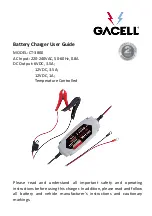
View front control panel and cross reference to fig.3 in these instructions to fully familiarise yourself with the Electrocharge 160. Successful selection
of a mode or function will be indicated by illumination of the appropriate LED and an audible signal.
4.1. BATTERY VOLTAGE SELECTION (fig 3. 1).
This key permits selection of the battery voltage. The voltages available are:
12 & 24 V.
4.2. OPERATING MODE SELECTION (fig. 3. 2).
This key will select one of the following operating modes:
CHARGE (+ STAND-BY), BOOST (+ STAND-BY)
a) Selection is performed by pressing the button until the LED display corresponds with required mode or setting.
b) Stand-by function provides a 12Volt 0.8A stabilised supply to power essential vehicle functions via the cigarette lighter socket.
This function is available with charging/starting and is not switched off when booster/charger is Off (see para. 3.1.3.)
c) Charge function permits charging of the battery at a preset constant current for a 10 hour period, but with the following automatic adjustments:
i) If the initial battery voltage is very low, a small current (2A) will be delivered until 1.5 V/cell is reached.
ii) When 1.5V/cell has been achieved the booster/charger will charge at the preset current.
iii) If the battery is not fully charged at the end of the 10 hour period, charging is extended for a further two hours after which the
booster/charger will automatically switch off.
iv) If, however, the battery reaches full charge before the end of the set time, booster/charger will then automatically switch current off.
d) Boost provides starting boost current,
at a constant voltage
, in cycles of
5 seconds ON, 20 seconds OFF.
4.3. CHARGE CURRENT (fig. 3. 3).
This key is used to select the required charging current.
The charge current settings are:
2, 5, 8, 12 & 16 Amps.
4.4. ON (fig. 3. 4).
Identified by
I
, this key switches on starter/charger output.
Important:
before pressing On key ensure you have selected
all required settings and power clamps are correctly attached to
battery terminals. If Boost has been selected booster/charger will
begin to deliver current only when the vehicle starter is operated.
4.5. OFF (fig. 3. 5).
This key, identified by an
O
, switches off current during Charge or
Boost modes.
p
WARNING!
When Off key is activated, the booster/charger
remains fully powered (230v supply is NOT interrupted) and
the stand-by output is maintained.
4.6. DISPLAY (fig. 3. 6).
Two displays can be selected with this key:
a)
I
Current (Amps) in Charge or Boost modes.
b)
V
Output voltage.
4.7. BATTERY CHARGE STATUS INDICATOR (fig. 3. 7).
Three LEDs indicate battery charge status.
100% LED - battery is charged to a voltage equal to, or higher than, the end-of-charge voltage.
50% LED - battery is still being charged but the charge level is acceptable.
0% LED - battery is flat.
4.8. ALARMS & SAFETY CUT OUT DEVICE (fig. 3.8).
The machine is protected against overloads, short circuits and inversion of polarity by means of an internal electronic safety cut out device.
Three LEDs indicate status:
- indicates thermal cut-out to protect against overloads/short circuits.
- indicates low, or no battery voltage.
- indicates inversion of polarity.
Note:
All alarm conditions stop the delivery of current to the battery but do not affect the auxiliary power supply. This is equipped with independent
safety devices, thus ensuring that power to the vehicle electronics is uninterrupted.
4
THE CONTROL PANEL
ELECTROCHARGE 160 - 0051 - (1) - 010699
fig. 3






















